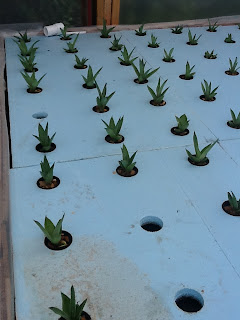Our venture into aquaponics started when our lush, abundant, first summer garden was, in the course of one week, decimated by cut worms, white flys and all the other crawlers that had descended onto it. I knew that I didn't want to go chemical as a response to that assault, but what else can you do? So we went to the web.
Some of the the videos that I found, on you tube, of aquaponic gardens were simply astounding. Lush, verdant rows of leaf and vine crops growing without pesticides at twice the speed of raised beds seemed impossible. Hundreds of talapia, circling indoor tanks, providing all the nutrients for the plants, while the plants scrubbed the water for the fish just seemed too perfect. Then I realized that this is just the way it works in the bigger environment. Just a smaller, easier to control, version.
The key to this microcosm was the greenhouse. Being able to control the rainfall, temperature, and well, all aspects of the environment would give me the ability to grow an organic, insect free garden. Then the bad news. The greenhouses available on the market were of two varieties, the $100 dollar, rickety, DIY PVC hoop house or the $40,000 Victorian glass atrium. Either I didn't want to own it or I couldn't afford to. I needed something in the middle, and preferably on the lower end of the middle.
Look as I might, I was unable to find anything online that would meet my requirements. Then one evening I was watching a PBS documentary on the cathedrals of Europe and in particular about how the strength of the segmented arch allowed these churches to raise to unachieved heights.
 |
| Cathedral of Reims, France. |
The next day I started playing around with the shape. I was able to find some information on line as to the the optimal ratio of radius to width, which helped greatly. Once the design on paper looked pretty good I started working on a prototype. I've had enough experience laying up boats and other curved structures ( bookcase from carols studio) that the jig layout was not a big project.
The biggest surprise was just how inexpensive the arches are to construct. Each segment arch for a 24' wide greenhouse is comprised of two 2x4s and half of a 2x6 ripped and glued up on a jig. About twelve bucks each including fasteners. To build a24'x40' I was going to need 22 arches. This would let me build my greenhouse for $500 buck or so. This is the neighborhood I was looking for.
 |
| Bookcase from Carol's Art Studio |
I took my drawings to a local structural engineer for review. He thought that the design would satisfy the new south Florida 160mph wind code with some modifications. With his input we redrew the plans in four sizes, added some exterior treatment choices, four or five foundation plans and some fastener schedules.
I made the decision to log and post anything ideas or process that I came up with during the development of our aquaponic system that someone else might get some benefit from. This led to our website www.shamrockaquaponicfarm.com. And to the blog that your reading now. It is my goal to keep the information free and any products to its bare minimum price possible.
With that said here we are. Keep an eye on this blog and Ill keep writing up any thing that seems worthwhile. Mat
 |
| Floor, Side and Front Elevation 24'x40' Greenhouse |
 My century plant went to seed earlier this season and when the pups started forming on the seed stalk it happened to coincide with the lettuce raft coming online for the first time. Since I had no starters plants yet I just put the pups in the net pots as they got to about an inch in size. It was amazing to see them go from one inch to six over the coarse of three weeks. With roots hanging down about ten inches I figured it was time to move them out into pots.
My century plant went to seed earlier this season and when the pups started forming on the seed stalk it happened to coincide with the lettuce raft coming online for the first time. Since I had no starters plants yet I just put the pups in the net pots as they got to about an inch in size. It was amazing to see them go from one inch to six over the coarse of three weeks. With roots hanging down about ten inches I figured it was time to move them out into pots.









